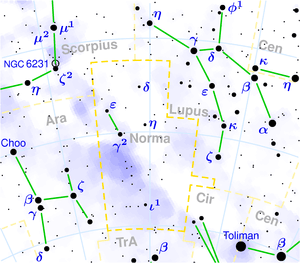|
|
Norma ( Latin: normal, as in right angle), is a small and inconspicuous constellation that lies in the southern hemisphere between Scorpius and Centaurus. The Milky Way passes through it. In English the constellation is variously known as The Rule, The Carpenter's Square, The Set Square and The Level. It was formally known as Norma et Regula, a Latin translation of Lacaille's original French name for the constellation, L'Équerre et La Règle, meaning "The Set Square and The Ruler". Notable features Norma has no α or β star; its brightest star, γ2 Normae, is only of magnitude 4.0. Among the constellation's principal stars are the following: * γ1 Nor and γ2 Nor comprise an easy optical double. γ2 Nor is itself a close optical double (HJ 4841). * ε Nor: a relatively fixed binary star (HJ 4853). The two components are of magnitude 4.54 and 6.68; the separation is 22" in PA 335°. The fainter component is itself a spectroscopic binary (mag 6.68 and 7.12). * ι1 Nor: a multiple star. The AB (mag 5.6 and 5.8) pair comprise a rapid binary with a period of 26.9 years; in 2000 the separation was 0.5" in PA 285°. Component C, of magnitude 8.75, is 11" away in PA 242°; it is not a physical member of the system, being only 55 light-years away, while the AB pair lie at a distance of more than 140 ly. * μ Nor is suspected of being an Alpha Cygni variable, with a range of 4.87–4.98. It is of spectral type O9.7 Iab. * R Normae is a Mira variable. Its visual range is 6.5–13.9 and its average period is 507.5 days. * S Normae is a well-known Cepheid variable with a range of 6.12–6.77 and a period of 9.75411 days. It is located at the centre of the open cluster NGC 6087. Notable deep-sky objects Due to its location on the Milky Way, this constellation contains many deep sky objects, the most notable of which is NGC 6087. * NGC 6067 is an open cluster, which lies less than 1° north of Kappa Normae. It contains about 100 stars of the tenth magnitude and has an integrated magnitude of 5.6m. * NGC 6087 is the brightest of the open clusters in Norma; it lies in the southeastern corner of the constellation between α Centauri and ζ Arae. It is about 3500 light-years away and contains about 40 stars of the seventh to the eleventh magnitude. Its brightest member is the Cepheid variable S Normae. It is of magnitude +5.4. * Sp 1 (or PK 329+02.1) is a planetary nebula better known as the Fine-Ring Nebula. It lies about five degrees west-northwest of γ1 Nor, though its actual distance has been variously estimated at 1000–4700 ly. Its integrated magnitude is 13.6 and its mean surface brightness is 13.9. The central star is a white dwarf of mag 14.03. History This constellation was named by Nicolas Louis de Lacaille during his stay at the Cape of Good Hope from 1751 to 1752. He originally called it Norma et Regula (the Normal (a Set Square) and the Ruler (a Level) ), referring to the carpenter's tools. The constellation had previously been called the Southern Triangle (no relation to Triangulum Australe) and Quadrans Euclidis (Euclid's square). Since it lies in the south, and was created in the 17th century, this constellation has no early or classical mythology associated with it. Changes in the boundaries of the constellations since Lacaille’s time have resulted in the removal of a number of bright stars from Norma. In particular, the stars that Lacaille designated α and β have been transferred to Scorpius and are now known as N Scorpii and H Scorpii respectively. References * Burnham, Robert Jr. (1966, 1978). Burnham's Celestial Handbook: An Observer's Guide to the Universe Beyond the Solar System, v.2. General Publishing Company, Ltd., Toronto. ISBN 0-486-23568-8. * Ian Ridpath and Wil Tirion (2007). Stars and Planets Guide Links
Retrieved from "http://en.wikipedia.org/"
|
|
||||||||||||||||||||||||||||||||||||||||||||||||||||
